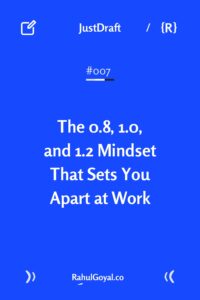The 0.8, 1.0, and 1.2 Mindset
Let’s talk about something important today—the kind of person you are or you meet and the impact you have on those around you. It’s easy to think about success in terms of big, bold moves, but often, the difference between standing out and blending in comes down to the small, everyday things.
One Topic: In my understanding, people fall into three categories: 0.8, 1.0, and 1.2 mindset
These numbers aren’t just random—they reflect how much value someone brings to a situation.
The 0.8 Person: Taking More Than They Give
We’ve all met the 0.8 person—the one who, instead of helping, seems to make things harder. You ask them to do something, and the result is disappointing. They might have a negative attitude, make careless mistakes, or simply lack enthusiasm. Interacting with them feels draining because they subtract value from whatever they touch.
Imagine asking a 0.8 person for something simple, like a drink. They bring it to you warm, maybe with a frown. The job is technically done, but the experience leaves you worse off.
So, Avoid being a 0.8 person. No one wants to work with someone who drains energy or effort from a team.
The 1.0 Person: Doing What’s Required, Nothing More
Then there’s the 1.0 person—the one who gets the job done, but only just. They meet expectations, but they don’t go beyond that. They show up, do the work, and leave. It’s like receiving exactly what you asked for, but nothing extra. These are the people who play it safe, do what’s expected, and maintain the status quo.
Picture a 1.0 person serving that same drink. It’s fine—nothing wrong with it, but nothing memorable either. It’s just a task completed.
While being a 1.0 person means you’re reliable, it won’t help you stand out. It’s about doing enough, but not making a difference.
The 1.2 Person: Adding More Value Than Expected
Finally, there’s the 1.2 person or 1.2 mindset. These are the people who go the extra mile. They deliver more than expected—not just in tasks, but in attitude, effort, and attention to detail. They make you feel like they genuinely care, and that little bit extra leaves a lasting impression.
Ask a 1.2 person for that same drink, and they’ll not only bring it to you perfectly chilled, but they’ll also serve it with a smile and ask if you need anything else. They make you feel seen and valued. It’s not just about doing the job; it’s about creating an experience.
Being a 1.2 person is about adding value in every situation. It’s a mindset that sets you apart and makes you indispensable in any role.
How to Become a 1.2 Person
Now, let’s get to the actionable part. Here’s how you can shift from being a 0.8 or 1.0 person to a 1.2 person:
- Focus on the Details: Pay attention to the small things that make a difference. Whether it’s remembering someone’s name or delivering a report with extra insights, these details add value.
- Show Up with a Positive Attitude: Your attitude is contagious. Bringing positivity and enthusiasm to your tasks can elevate the experience for everyone.
- Exceed Expectations: Always look for ways to go beyond what’s required. Whether it’s completing work early, providing additional resources, or simply offering help where it’s not expected, this extra effort matters.
- Be Solution-Oriented: Instead of focusing on problems, focus on solutions. A 1.2 person is proactive and always looking for ways to improve the situation.
- Care About People: Treat everyone with respect and kindness. People remember how you make them feel, and that’s what sets you apart.
The Takeaway
Being a 1.2 person isn’t about grand gestures—it’s about consistently adding value in small but meaningful ways. Whether you’re leading a team, working with clients, or simply collaborating with coworkers, that little extra effort will set you apart and make a lasting impact.
Read last week’s JustDraft newsletter about Famous Japanese life changing concepts.
Two Quotes
Success comes to those who make others feel important, not just themselves.
Greatness is found in the extra effort, in the 1.2 mindset, not just meeting the baseline.
One Passage
For artists, scientists, inventors, students, and the rest of us, intrinsic motivation—the drive to do something because it is interesting, challenging, and absorbing—is essential for high levels of creativity. But our Brains and bodies are wired for goal-setting in two different ways: The first focuses on short-term goals, giving us bursts of motivation. The second, long-term goals, brings sustained effort and passion for something greater than the here and now.
From Drive: The Surprising Truth About What Motivates Us by Daniel H. Pink

